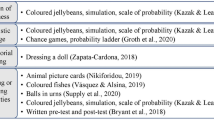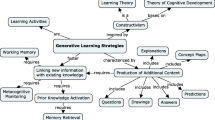Abstract
This paper is a case study of how a high school student, whom we call Karen, used a computer-based tool, the Contour Analyzer, to create graphs of height vs. distance and slope vs. distance for a flat board that she positioned with different slants and orientations. With the Contour Analyzer one can generate, on a computer screen, graphs representing functions of height and slope vs. distance corresponding to a line traced along the surface of a real object. Karen was interviewed for three one-hour sessions in an individual teaching experiment. In this paper, our focus is on how Karen came to recognize by visual inspection the mathematical behavior of the slope vs. distance function corresponding to contours traced on a flat board. Karen strove to organize her visual experience by distinguishing which aspects of the board are to be noticed and which ones are to be ignored, as well as by determining the point of view that one should adopt in order to ‘see’ the variation of slope along an object. We have found it inspiring to use Winnicott's (1971) ideas about transitional objects to examine the role of the graphing instrument for Karen. This theoretical background helped us to articulate a perspective on mathematical visualization that goes beyond the dualism between internal and external representations frequently assumed in the literature, and focuses on the lived-in space that Karen experienced which encompassed at once physical attributes of the tool and human possibilities of action.
Similar content being viewed by others
REFERENCES
Barwise, J. and J. Etchemendy: 1991, ‘Visual information and valid reasoning’, W. Zimmerman and S. Cunningham (eds.), Visualization in Teaching and Learning Mathematics, Mathematical Association of America, MAA Notes Series, 10–24.
Bishop, A.: 1989, ‘Review of research on visualization in mathematics education’, Focus on Learning Problems in Mathematics 11(1), 7–16.
Borba, M.: 1993, Students' Understanding of Transformations of Functions Using Multi-Representational Software, Unpublished doctoral dissertation, Cornell University, Ithaca, NY.
Cobb, P., E. Yackel, and T. Wood: 1992, ‘A constructivist alternative to the representational view of mind’, Journal for Research in Mathematics Education 23(1), 2–33.
Davis, P. and J. Anderson: 1979, ‘Nonanalytic aspects of mathematics and their implication for research and education’, SIAM Review 21(1), 112–127.
Dörfler, W.: 1991, ‘Meaning: Image schemata and protocols’, Proceedings of the 15th Annual Meeting of the International Group for the Psychology of Mathematics Education 1, 17–32.
Dreyfus, T.: 1991, ‘On the status of visual reasoning in mathematics and mathematics education’, Proceedings of the 15th Annual Meeting of the International Group for the Psychology of Mathematics Education 1, 33–48.
Galindo, E.: 1995, ‘Visualization and students' performance in technology-based calculus’, Proceedings of the 17th Annual Meeting of the International Group for the Psychology of Mathematics Education 2, 321–327.
Goldenberg, E. P.: 1991, ‘Seeing beauty in mathematics: Using fractal geometry to build a spirit of mathematical inquiry’, W. Zimmerman and S. Cunningham (eds.), Visualization in Teaching and Learning Mathematics, Mathematical Association of America, MAA Notes Series, 39–66.
Heidegger, M.: 1927/1962, Being and Time, Harper-Collins, San Francisco, CA.
Hershkowitz, R., A. Friedlander, and T. Dreyfus: 1991, ‘Loci and visual thinking’, Proceedings of the 15th Annual Meeting of the International Group for the Psychology of Mathematics Education 2, 181–188.
Horgan, J.: 1993, ‘The death of proof’, Scientific American October Issue, 92–103.
Marton, F. and R. Saljo: 1984, ‘Approaches to learning’, F. Marton, D. Hounsell and N. Entwistle (eds.), The Experience of Learning, Scottish Academy Press, Edinburgh.
Meira, L.: in press, ‘Making sense of instructional devices: The emergence of transparency in mathematical activity’, Journal of Mathematical Behavior.
Merleau-Ponty, M.: 1946/1989, Phenomenology of Perception, Routledge, London.
Monk, S. and R. Nemirovsky: 1994, ‘The case of Dan: Student construction of a functional situation through visual attributes’, CBMS Issues in Mathematics Education 4, 139–168.
Moschkovich, J.: 1996, ‘Moving up and getting steeper: Negotiating shared descriptions of linear graphs’, Journal of the Learning Sciences 5(3), 239–277.
Nemirovsky, R.: 1994, ‘On ways of symbolizing: The case of laura and velocity sign’, The Journal of Mathematical Behavior 13, 389–422.
Nemirovsky, R., C. Tierney and T. Wright: 1995, ‘Body motion and graphing’, Paper presented at the 1995 Annual Meeting of the American Educational Research Association, San Francisco, CA.
Nemirovsky, R., C. Tierney and T. Wright: forthcoming, ‘Body motion and graphing’, Cognition and Instruction.
Papert, S.: 1980, Mindstorms: Children, Computers, and Powerful Ideas, Basic Books, New York.
Presmeg, N.: 1986, ‘Visualization in high school mathematics’, For the Learning of Mathematics 6(3), 42–46.
Presmeg, N.: 1989, ‘Visualization in multicultural mathematics classrooms’, Focus on Learning Problems in Mathematics 11(1), 17–24.
Presmeg, N.: 1992, ‘Prototypes, metaphors, metonymies and imaginative rationality in high school mathematics’, Educational Studies in Mathematics 23, 595–610.
Rival, I.: 1987, ‘Picture puzzling: Mathematicians are rediscovering the power of pictoral reasoning’, The Sciences 27, 41–46.
Shama, G. and T. Dreyfus: 1991, ‘Spontaneous strategies for visually presented linear programming problems’, Proceedings of the 15th Annual Meeting of the International Group for the Psychology of Mathematics Education 3, 262–269.
Schnotz, W., T. Zink and M. Pfeiffer: 1995, ‘Visualization in learning and instruction: Effects of graphic representation formats on the structure and application of knowledge’, Research Report 5, Freidrich-Schiller University of Jena.
Tall, D.: 1991, ‘Intuition and rigor: The role of visualization in calculus’, W. Zimmerman and S. Cunningham (eds.) Visualization in Teaching and Learning Mathematics, Mathematical Association of America, MAA Notes Series, 105–120.
Teasley, S. and J. Roschelle: 1993, ‘Constructing a joint problem space: The computer as a tool for sharing knowledge’, S. P. Lajoie and S. J. Derry (eds.), Computers as Cognitive Tools, NEA, Hillsdale, NJ.
Winnicott, D. W.: 1971, Playing and Reality, Basic Books, New York.
Yerushalmy, M. and D. Chazan: 1990, ‘Overcoming visual obstacles with the aid of the supposer’, Educational Studies in Mathematics 21, 199–219.
Zazkis, R., E. Dubinsky and J. Dautermann: 1996, ‘Using visual and analytic strategies: A study of students' understanding of permutation and symmetry groups’, Journal of Research in Mathematics Education 27(4), 435–457.
Zimmerman, W. and S. Cunningham: 1991, ‘Editor's introduction: What is mathematical visualization?’, W. Zimmerman and S. Cunningham (eds.), Visualization in Teaching and Learning Mathematics, Mathematical Association of America, MAA Notes Series, 1–8.
Author information
Authors and Affiliations
Rights and permissions
About this article
Cite this article
Nemirovsky, R., Noble, T. On Mathematical Visualization and the Place Where We Live. Educational Studies in Mathematics 33, 99–131 (1997). https://doi.org/10.1023/A:1002983213048
Issue Date:
DOI: https://doi.org/10.1023/A:1002983213048




